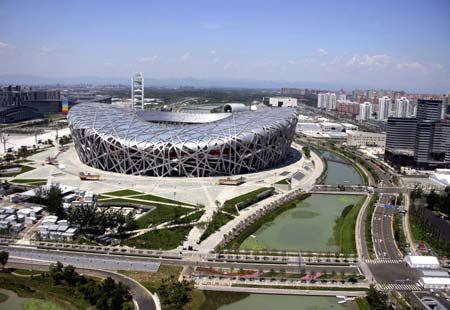Beijing has mobilized all its science and engineering capabilities, including satellite monitoring and cloud seeding, to prevent rain from spoiling the opening ceremony of the Olympic Games on Aug 8. Historical data indicates a 41 percent chance of precipitation on that date.
 An aerial view shows the National Stadium, also known as the Bird's Nest, at the Olympic Green in Beijing July 6, 2008.[Agencies]
An aerial view shows the National Stadium, also known as the Bird's Nest, at the Olympic Green in Beijing July 6, 2008.[Agencies] |
The Beijing weather engineering office is taking the lead in the weather modification.
Its task is to prevent rain from falling for three and half hours - from 8:08 pm to around 11:30 pm - onto the Bird's Nest, the open-air National Stadium.
A technology developed by American scientists, cloud seeding is achieved by shooting shells or rockets containing silver iodide particles into the clouds. The icy particles freeze droplets in the clouds, expanding the droplets that eventually fall out of the sky.
The weather engineering office is weaving a defensive web from adjacent provinces to the Beijing suburbs. Twenty-six control stations have been set up to fend off clouds or delay their movement.
The office has hired 32,000 people, and will deploy light aircraft, rockets and shells to shoot silver iodide crystals or dry ice into the clouds 50 km upwind of Beijing. Results will be reported from control stations to the headquarters within 10 minutes.
One silver iodide shell costs up to 88 yuan ($13), a rocket is priced at 2,000 yuan, and an aircraft much more. About 100 shells or four rockets will be used at any one time.
Meteorologists will need to capitalize on radar and weather satellites to monitor storms, usually unpredictable, and warn Olympic weather services.
Research and experiments have been carried out since 2001 when Beijing successfully bid for the Olympic Games.
Many meteorologists agree that cloud seeding is only effective on small or mid-sized clouds and thus impossible to influence giant storm systems, which can cover up to 100 sq km. The methodology employed is basically to speed up rain, delay rain, or change its location, experts said.
Some meteorologists argue that the study of cloud formations and large-scale weather conditions are insufficient to effectively modify the weather. Others dispute the negative impact of spreading silver iodide on the environment.
Yu Xinwen, a China Meteorological Administration (CMA) spokesman, said yesterday that the statistical probability of 41 percent is only a rough guess on the chance of precipitation.
A case in point is the 15th Asian Games in December 2006 in Doha, Qatar. In a country where rain is rarely seen, a deluge soaked athletes and spectators during the opening ceremony.
However, Yu said: "It's possible to predict the weather on the opening night one week in advance, and prediction accuracy will scale up leading to Aug 8." He expected more precise predictions about two days before the Olympics.
Early August is often warm and humid, and might not be an ideal time for the Olympics. Many feel the Beijing Olympic organizers deliberately chose the auspicious eighth day of the eighth month. However, organizers said this was not so.
Decision-makers were told by meteorologists that the first week in August is usually the wettest period each year in Beijing.
It was reported that the Beijing organizers proposed to the International Olympic Committee (IOC) to start the Games, on Aug 15. The final decision of Aug 8 by the IOC left Beijing with only one choice, to prevent rain, at least in the vicinity of the Bird's Nest.
The urgency of engineering the weather is due to the fact the main stadium has no roof.